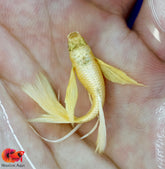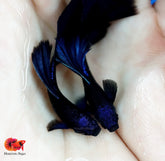Betta Care Guide: Everything You Need to Know to Keep Your Betta Fish Happy and Healthy
Betta fish, also known as Siamese fighting fish, are among the most popular and beautiful freshwater fish kept as pets. Their vivid colors, long fins, and unique personalities make them a favorite for aquarists of all experience levels. But despite their hardy nature, bettas require proper care to thrive.
In this ultimate Betta Care Guide, we’ll cover everything from tank setup and feeding to health and behavior — so your betta lives a long, vibrant life.
🌿 Why Bettas Make Great Pets
Bettas are low-maintenance, intelligent, and full of character. Unlike schooling fish, they can live alone, which makes them ideal for smaller spaces and new fish owners. They also come in a dazzling variety of colors and tail types — from Halfmoons to Crowntails — each with its own charm.
🏡 Betta Tank Setup: Creating the Right Environment
🐟 Minimum Tank Size
Many people mistakenly believe bettas can live in tiny bowls. The recommended minimum tank size is 5 gallons (19 liters). This allows enough space for swimming and reduces water quality issues.
🌡️ Water Temperature and Parameters
-
Temperature: 76–82°F (24–28°C)
-
pH: 6.5–7.5
-
Ammonia/Nitrites: 0 ppm
-
Nitrates: <20 ppm
A heater and filter are essential to maintain stable water conditions.
🪴 Plants and Decorations
Live or silk plants offer hiding spots and reduce stress. Avoid sharp or rough decor that could tear their delicate fins. Popular plant choices include Java fern, Anubias, and Marimo moss balls.
🍽️ Feeding Your Betta: Diet and Schedule
Bettas are carnivorous and need high-protein foods.
🥩 Best Betta Foods:
-
Pellets (specifically for bettas)
-
Frozen or live foods like bloodworms, daphnia, and brine shrimp
📅 Feeding Tips:
-
Feed once or twice a day, only what your betta can eat in 2 minutes.
-
Fasting one day a week helps prevent bloating and constipation.
🧼 Betta Tank Maintenance
Regular tank maintenance keeps your fish healthy and water safe.
Weekly Checklist:
-
Test water parameters
-
Change 25–50% of the water
-
Clean uneaten food and waste
-
Rinse filter media (in tank water, not tap)
❤️ Understanding Betta Behavior
💃 Signs of a Happy Betta:
-
Active swimming
-
Building bubble nests
-
Bright coloration
-
Responsive to your presence
🚩 Warning Signs:
-
Lethargy
-
Clamped fins
-
Faded colors
-
Refusing food
-
White spots or fin rot
Knowing how your betta normally behaves helps you detect health issues early.
🧪 Common Betta Fish Diseases
| Disease | Symptoms | Treatment |
|---|---|---|
| Fin Rot | Ragged fins, dark edges | Aquarium salt, antibacterial meds |
| Ich (White Spot) | White dots, scratching on objects | Heat increase + ich treatment |
| Swim Bladder | Floating/sinking issues | Fasting, peas (occasional), clean water |
Prevention is always better than cure — clean water and good food go a long way.
🤔 Can Bettas Live with Other Fish?
While male bettas are territorial, they can live in a community tank with the right tank mates:
-
Peaceful, non-fin-nipping species
-
No other male bettas
-
No brightly colored or long-finned fish
Good tank mates include: Corydoras, Ember tetras, and Nerite snails.
🐣 Bonus: Betta Care for Beginners
If you're new to betta keeping, here are some quick tips:
-
Cycle your tank before adding your betta
-
Avoid overfeeding
-
Get a thermometer and test kit
-
Don’t use plastic plants
-
Talk to your betta! (They’ll recognize you)
📦 Final Thoughts: Betta Care Is a Rewarding Journey
Caring for a betta is both fun and fulfilling. With the right knowledge, setup, and attention, your betta can live 3–5 years or more in optimal conditions. This guide covers the essentials, but always keep learning — each betta has its own quirks and preferences.






